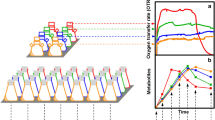Summary
A culture of Bacillus subtilis, in which the relative production of acetoin (Ac) and butanediol (Bu) is highly sensitive to oxygen tension as well as to mixing conditions, was used to evaluate several culture conditions in 500-ml shake flasks. The concentration ratio of these metabolites (Ac/Bu) produced in a defined period of culture time was used as a parameter for comparative purposes. The influence of working volume, shaking speed, broth viscosity and the presence of baffles were evaluated. Using unbaffled flasks it was found that working volume had the most influence on oxygenation in shake flasks, especially below 10%, where differences in Ac/Bu ratios up to ten times could be measured. Shaking speed played an important role only at values higher than 400 rpm or when small working volumes were used. The addition of xanthan gum decreased the Ac/Bu ratio nearly four times under equivalent working conditions and also diminished the influence of shaking speed. In general, Ac/Bu was higher when sulphite oxygen transfer rate (OTR) values were higher. However, the test culture was able to detect differences which were not evident using the OTR method. Comparing Ac/Bu ratios in stirred fermentors from the literature, it seems that similar oxygenation conditions can be reached in non-baffled shake flasks only at very high shaking speeds using small working volumes. With baffled flasks, our data suggest that better oxygenation and mixing can be achieved in shake flasks if compared with those obtained in stirred fermentors at conventional power inputs.
Similar content being viewed by others
References
Auro M, Hidge H, Roth N (1957) Oxygen absorption rates in shaken flasks. Ind Eng Chem 49:1237–1238
Calam CT (1986) Shaken flasks fermentations. In: Demain AL, Solomon NA (eds) Manual of industrial microbiology and biotechnology. American Society for Microbiology, Washington, DC, pp 59–65
Cooper CM, Fernstrom GA, Miller S (1944) Performance of agitated gas liquid contactors. Ind Eng Chem 36:504–509
Chain E, Gualandi G (1954) Aeration studies II. Rend Ist Super Sanita 17:5–60
Flach EA, Heden CG (1963) Disposable shaken flasks. Biotechnol Bioeng 5:211–220
Freedman D (1969) The shaker in bioengineering. Process Biochem 2:35–40
Gaden EL (1962) Improved shaken flask performance. Biotechnol Bioeng 4:99–103
Griot M, Moes J, Heinzle E, Dunn IJ, Bourne JR (1986) A microbial culture for the measurement of macro and micro mixing phenomena in biological reactors. In: Stanbury J (ed) International Conference on Bioreactor Fluid Dynamics, Cambridge, UK, Proc BHRA, The Fluid Engineering Centre, Cranfield, UK, pp 203–216
Griot M, Saner U, Heinzle E, Dunn IJ, Bourne JR (1988) Experience with an oxygen-sensitive culture for fermentor scale up. In: King R (ed) 2nd International Conference on Bioreactor Fluid Dynamics, Cambridge, UK. Proceedings BHRA, The Fluid Engineering Centre Cranfield, UK, pp 17–35
McDaniel L, Bailey G (1969) Effect of shaking speed and type of closure on shaken flask cultures. Appl Microbiol 17:286–290
McDaniel LE, Bailey EG, Zimmerli A (1965a) Effect of oxygen supply rates on growth of Escherichia coli: I. Studies in unbaffled and baffled shaken flasks. Appl Microbiol 13:109–114
McDaniel L, Bailey E, Zimmerli A (1965b) Effect of oxygen-supply rates on growth of Escherichia coli: II. Comparison of results in shake flasks and 50 liter fermentor. Appl Microbiol 13:115–119
Moes J, Griot M, Keller J, Heinzle E, Dunn IJ, Bourne JR (1985) A microbial culture with oxygen sensitive product distribution as a potential tool for characterizing bioreactor oxygen transport. Biotechnol Bioeng 27:482–489
Moes J, Griot M, Heinzle E, Dunn IJ, Bourne JR (1986) A microbial culture as an oxygen sensor for reactor mixing effects. Ann NY Acad Sci 469:118–130
Rhodes R, Gaden E (1957) Characterization of agitation effects in shaken flasks. Ind Eng Chem 49:1233–1236
Ruchti G, Dunn IJ, Bourne JR, Stockar U von (1985) Practical guidelines for the determination of oxygen tansfer coefficients (kLa) with the sulfite oxidation method. Chem Eng J 30:29–38
Schultz J (1964) Cotton closure as an aeration barrier in shaken flask fermentation. Appl Microbiol 12:305–310
Smith G, Johnson MJ (1954) Aeration requirements for the growth of aerobic microorganisms. J Bacteriol 8:346–350
Suidjam JC van, Kossen NW, Joha AC (1978) Model for oxygen transfer in a shaken flask. Biotechnol Bioeng 20:1695–1709
Yamada S, Wada M, Chibata I (1978) Oxygen transfer in shaken flask cultures and the conversion of sorbitol to sorbose by Acetobacter suboxydans. J Ferment Technol 56:20–28
Author information
Authors and Affiliations
Rights and permissions
About this article
Cite this article
Delgado, G., Topete, M. & Galindo, E. Interaction of cultural conditions and end-product distribution in Bacillus subtilis grown in shake flasks. Appl Microbiol Biotechnol 31, 288–292 (1989). https://doi.org/10.1007/BF00258411
Received:
Accepted:
Issue Date:
DOI: https://doi.org/10.1007/BF00258411




